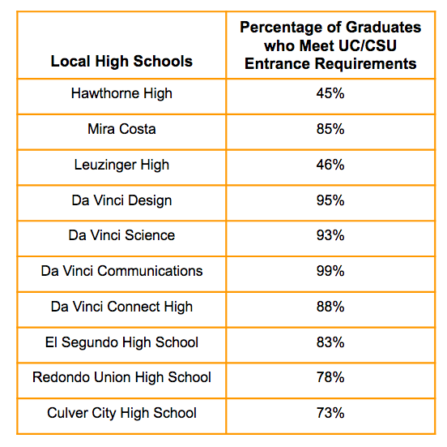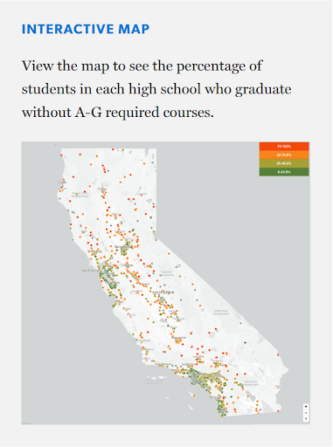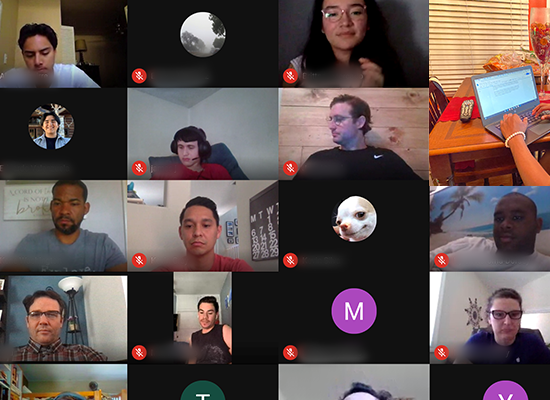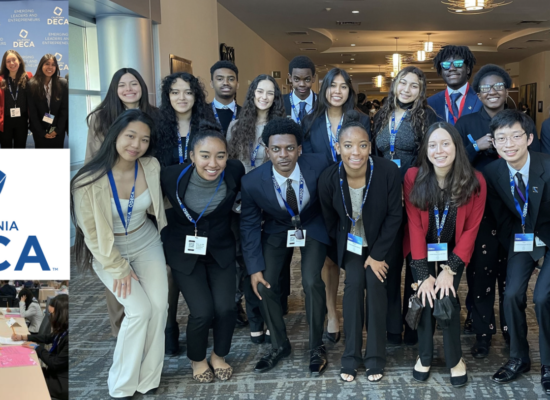
Most CA High School Seniors Have Not Met the “A-G Requirements” to Apply to the State’s Public Universities
This month EdSource released its analysis of the 2023 A-G requirement records from the California Department of Education and found that most high school seniors in California are shut out from applying to the state’s public University of California and Cal State universities. (This is not the case at Da Vinci Schools – more info below.)
In the article, EdSource indicates that in 2023, 86% of high school seniors met the requirements to graduate from high school, but only 44% of California high school seniors completed the minimum coursework required to be eligible to apply to the state’s universities.
This means that in 2023, more than half of the high school seniors in California were not eligible to apply to a public California university, like Long Beach State or UCLA, upon high school graduation.
In EdSource’s analysis, the statistics were meaningfully worse for Black and Latino students. EdSource’s analysis of the state’s data found that in 2023, only 32% of Black students and 36% of Latino high school seniors met the minimum requirements to apply to the state’s universities.
So what are the “minimum requirements” students need to be eligible to apply to a California state public university?
They’re what we commonly refer to as “A-G requirements”.
A-G eligibility requirements get their name from the fact that there are seven categories, labeled A through G, that students must take 15 courses in to meet the minimum requirements to apply to a UC or Cal State university. These courses cover a series of subjects such as A) History B) English C) Mathematics D) Science E) Language other than English F) Visual and Performing Arts G) College-preparatory elective, hence the name A-G. You can learn more here.
These courses often overlap with high school graduation requirements, but they are also more rigorous. For instance, two courses in mathematics, including Algebra I, are required to graduate from a California high school, while A-G eligibility requires three years of mathematics, including algebra, geometry, and intermediate algebra (UC admission recommends four years). Additionally, to graduate from high school in California, students must get at least a “D” grade in their classes, but to get credit for meeting A-G requirements, students must get at least a “C” grade.
Some of the common ways students fall off the A-G track in high school are low grades, and/or just not knowing what classes they should choose in order to be on the A-G track and stay on it. In most schools, the A-G track is a choice, and the choice requires that students and families know what classes meet the requirements to stay on the A-G track, and which classes don’t.
Aligning Graduation Requirements with A-G Completion
At Da Vinci Schools, students can’t make a wrong choice.
“At Da Vinci Schools, we made a strategic decision at our inception that we would offer classes that meet the A-G eligibility requirements,” said Dr. Matthew Wunder, CEO and superintendent of Da Vinci Schools. “We made this decision because we felt it was too easy for students to fall through the cracks without intending to, and we wanted every student and every family to know that they couldn’t make a wrong choice as far as classes go; whatever class they choose would count toward California’s public university eligibility requirements. We also had—and still have — a very fundamental and passionate belief that all kids can do it; all kids have the capacity to satisfy the more rigorous requirements of getting an A-G high school education. And all kids should be eligible to apply for the university of their choice upon completion of high school, regardless of whether they choose to go to college or not,” he continued.
Below is a chart that shows the percentage of graduates who meet the A-G entrance requirements in Da Vinci’s 201 N. Douglas St high schools, and in the other local surrounding high schools:

According to Great Schools, the percentages above represent the percent of graduates who got a “C” or higher in the A-G courses required for eligibility at California’s universities.
As you can see, Da Vinci’s schools are more than double the California average of 44%, and meaningfully higher than the neighboring high school schools in our area; this is due almost entirely to our “can’t fail to complete A-G” strategic design.

Because Da Vinci’s model–by design–won’t let students fail to meet the A-G requirements, we also offer seminars–so that our students can still have fun, do seminars that are enjoyable, and they can take a break from the rigors of the A-G requirements, and not torpedo their transcript.
We also use a project-based learning model in all our schools, which means our students study the A-G curriculum, in a project-based, real world learning environment–where they learn by doing, so that they can become masters of the material, rather than just memorizers of it.
Today, nearly all of Da Vinci Design, Da Vinci Science, Da Vinci Communications, and Da Vinci Connect High students meet the A-G requirements (Great Schools Data: Da Vinci Design at 95%, Da Vinci Science at 93%, Da Vinci Communications at 99%, Da Vinci Connect High at 88%).
Furthermore, our college-going rate for the class of 2023 was at 80%, which means that 80 percent of the students who graduated from our high schools with the class of 2023 enrolled in a public or private post-secondary institution within 12-16 months after completing high school. These numbers are exceptional and meaningfully higher than the state’s average.
“Our numbers are extraordinary and humbling,” said Dr. Wunder. “They are extraordinary because our kids, our educators, and our staff are working really hard to be different from the status quo so that we can positively impact life outcomes in meaningful ways. The numbers are humbling, because in looking at the numbers for kids across the state of California, and across the country, we are reminded of how much more work still needs to be done in education for youth.”
Da Vinci Schools regularly hosts workshops teaching its model, and personnel regularly attend conferences to share best practices and learn about ways educators across the globe are continuing to move the needle and positively impact kids.
Should you have questions about your child’s A-G status, please don’t hesitate to connect with one of your child’s school counselors linked here.



